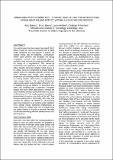| dc.contributor.author | Bueno, Bruno | |
| dc.contributor.author | Nakano, Aiko | |
| dc.contributor.author | Norford, Leslie Keith | |
| dc.contributor.author | Reinhart, Christoph | |
| dc.date.accessioned | 2017-05-09T15:28:13Z | |
| dc.date.available | 2017-05-09T15:28:13Z | |
| dc.date.issued | 2015-12 | |
| dc.identifier.uri | http://hdl.handle.net/1721.1/108779 | |
| dc.description.abstract | It is well known that local urban heat island (UHI) effects impact the urban environment from a public health standpoint and with regards to heating and pooling energy used by buildings. Unfortunately, neither urban planners and designers nor energy consultants currently have quantitative tools or methods at their disposal to incorporate this effect into the design of a neighborhood. This manuscript demonstrates the application of the earlier reported Urban Weather Generator (UWG) model (Bueno et al., 2012a, 2014) as a design tool to provide climatespecific advice for cityscape geometry and land use. UWG estimates local hourly urban canopy air
temperature and humidity profiles from measurements at a nearby weather station based on neighborhoodscale energy balances. The morphed temperature output can be used to study the effect of localized UHI
on building energy use profiles. To accomplish this, UWG was combined with a parametric simulation module that works either stand-alone or through the urban modeling interface (umi) (Reinhart et al., 2013)
in Rhinoceros 3D. The newly proposed workflow is demonstrated through a case study of the MIT East Campus development in Cambridge, MA, USA, that includes the addition of 130,000 m2 of laboratory space and residences to an existing urban condition. IPCC climate change predictions (Nakicenovic & Swart, 2000) are coupled with UHI to capture local and global heating on the site to promote thermally comfortable and energy-efficient development at each planning phase. | en_US |
| dc.description.sponsorship | Singapore-MIT Alliance for Research and Technology. Center for Environmental Sensing and Modeling | en_US |
| dc.language.iso | en_US | |
| dc.publisher | International Building Performance Simulation Association | en_US |
| dc.relation.isversionof | https://www.ibpsa.org/proceedings/BS2015/p2909.pdf | en_US |
| dc.rights | Creative Commons Attribution-Noncommercial-Share Alike | en_US |
| dc.rights.uri | http://creativecommons.org/licenses/by-nc-sa/4.0/ | en_US |
| dc.source | MIT web domain | en_US |
| dc.title | Urban Weather Generator - a Novel Workflow for Integrating Urban Heat Island Effect within Urban Design Process | en_US |
| dc.type | Article | en_US |
| dc.identifier.citation | Nakano, Aiko et al. "Urban Weather Generator - a Novel Workflow for Integrating Urban Heat Island Effect Within Urban Design Process." 14th Conference of International Building Performance Simulation Association, BS2015, 7-9 December, 2015, Hyderabad, India, IBPSA, 2015. | en_US |
| dc.contributor.department | Massachusetts Institute of Technology. Department of Architecture | en_US |
| dc.contributor.mitauthor | Nakano, Aiko | |
| dc.contributor.mitauthor | Norford, Leslie Keith | |
| dc.contributor.mitauthor | Reinhart, Christoph | |
| dc.relation.journal | Proceedings of the 14th Conference of International Building Performance Simulation Association, BS2015 | en_US |
| dc.eprint.version | Author's final manuscript | en_US |
| dc.type.uri | http://purl.org/eprint/type/ConferencePaper | en_US |
| eprint.status | http://purl.org/eprint/status/NonPeerReviewed | en_US |
| dspace.orderedauthors | Nakano, Aiko; Bueno, Bruno; Norford, Leslie; Reinhart, Christoph F. | en_US |
| dspace.embargo.terms | N | en_US |
| dc.identifier.orcid | https://orcid.org/0000-0002-5631-7256 | |
| dc.identifier.orcid | https://orcid.org/0000-0001-6311-0416 | |
| mit.license | OPEN_ACCESS_POLICY | en_US |
